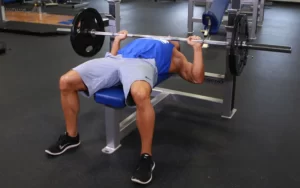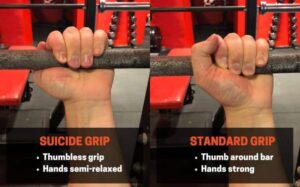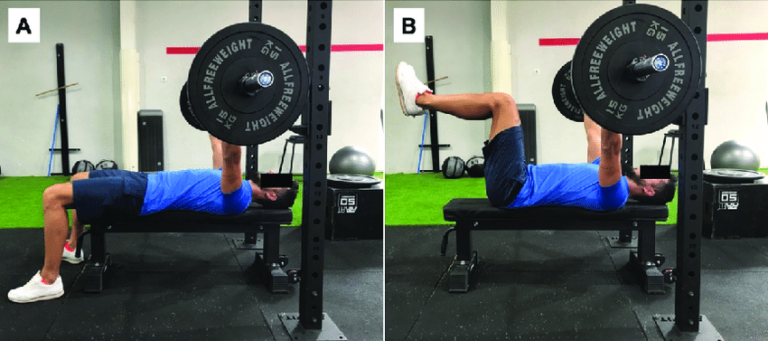What is a Bench Press for and Why should you do it?
Strength training is the cornerstone of any good fitness program. Bench press will not only make you strong in a position but also in everyday life has a positive impact on your health. The bench press is an exercise that targets all three of the major muscle groups in your upper body: the pectorals, the deltoids, and the triceps.
The barbell bench press is the most popular. If you’re big into weight training, you’ve probably been told that you need to bench press. The bench press is a big part of bodybuilding, powerlifting, and many other strength training programs.
You know that the bench press is an essential lift if you are looking to build muscle. But did you know that it also strengthens the triceps, shoulders and core muscles too?
This article will give you a quick rundown of the benefits of bench pressing and will also tell you which parts of your body you are hitting when you bench press.
How much weight should you start with??
If you’re still learning how to do bench press, don’t start with a heavy weight. Work your way up as you learn correct form. Experimenting with the number of reps is the second step to mastering the bench press.
To start with, I would suggest to perform the sets with only the barbell. You will need to repeat the sets until –
- you start feeling complete focus on the chest muscle only.
- you will start feeling 100% focused on every upward and downward movement.
- you will feel soreness and stress on the whole chest muscle then you can consider you are on the right path.
Once you are able to experience above for around 12-15 reps, slowly increase the weights. Simple way to start is to add 2.5 kg plates on each side and then progress with 2.5kg on each rep. Having said that, with increased weight, try to keep 12-15 reps but if you feel losing for in 12 reps, go for max 10 reps.
Likewise, you have to keep a target weigth of 50% of your bodweight in your mind. Unless you reach to that limit, don’t think to go for heavier load by looking at others. In other words, strictly avoid ego lifting. I have personally felt the consequences of this so telling you this based on my personal experience.

Building a strong base with Push-Ups
Needless to say that in order to master any compound movement, we need to first master our bodyweight movements. The reason is if you cannot do bodyweight push ups properly, how can you expect bench press to be perfect. However, there can be situations where you are not able to perform even 10 push ups in a row. If this is the case, then go for below process step by step –
- Start with knee push ups. This push up is also called beginner push ups. You just need to go onto your knees, hands roughly shoulder width apart. Now go down exhaling and come up inhaling. Perform this for the first week – 10reps x 3sets. In fact, you will need to increase 1 or 2 reps every week for 4 weeks. Once you are able to reach 15, go for standard push ups and target for 8-10 reps for 3 sets.


- Alternatively, if you feel difficulty in knee push up also, go for Incline Push Ups for 10-15 reps x 3 sets. More the height, easier it becomes, so choose as per your strength level.
- Decline Push Ups. Once you reach to 12-15 reps of standard push ups for 3 sets, start performing decline push ups. In general, this need more strength as you work more against gravity. Hencefoth, this will add more strength to your upper body muscles sush as Upper chest, Shoulders, Triceps, Traps.
For more details on a perfect Push Up – Click Here.

Proper form while performing the Bench Press
Focus on staying as solid as possible on the bench for optimum strength and growth increases. This will help to build tension from head to toe and get the most out of every rep. Don’t focus too much on lifting heavy at the initial stage. When it comes to any workout be it compound or isolation, proper form is an extreme requirement. For this reason, you need to take care of below while and before performing the bench press –
1. Three Points Contact
- It is recommended that your feet remain on the ground beneath or behind your knees. Pressing your feet into the ground will result in increased tension in your glutes and hamstrings.
- Create an arch in the lower back so your hips will make a second point of contact.
- To create a solid foundation, keep the shoulders retracted and pressing firmly into the bench throughout the lift to make the third point of contact.

2. Execution

It is advisable to have a spotter. However, if you don’t have one, stop before you reach failure so you may re-rack the bar securely.
- Begin by performing a hard lock-out with the bar right over your shoulders.
- Lower the bar for one or two seconds under control to the approximate location of a chest strap heart rate monitor, then press until your elbows are straight and the bar is under control.
- Before releasing the strain in your arms, re-rack carefully and make sure the bar is secure and don’t fall off, to avoid any injury.
DONT's while performing Bench Press
1. Ignoring arching the lower back

As you raise and lower the weight, you need to keep a firm arch in your lower back, so work on getting into this posture before you even place your hands on the bar. Tensing your glutes hard allows you to maintain an arch in your lower back and keep your core braced, which is vital to maintaining both your upper and lower body steady.
2. Not contracting the Shoulder Blades
You need your shoulder blades to strictly stay motionless during a bench press. This largely helps to stabilise the barbell and prevent shoulder damage while lifting large weights. Furthermore, set your shoulder blades by drawing them back and down as if attempting to press them into your back pockets before raising the bar out of the rack. When unracking the bar, imagine pushing yourself into the bench rather than raising the bar upwards. Sounds too technical right?? but implement these again and again, it will help a lot.
3. Lifting too heavy
This sounds like a bummer, right? But believe me, the more you take care of this, more you help yourself to avoid injury and loosing the form. What happens here is, when you lift too heavy, your hips try to lift itself to support the chest. In addition to this, the tension starts to shift to your shoulder blades and thus you tend to lose your form.

4. Flaring the elbows

Do not flare your elbows while doing bench press. Ideal rule of thumb is to keep your elbows close in approx. 45 degrees of angle. This helps in keeping away unnecessary tension from the shoulders and to focus completely on the chest muscles.
5. Using thumbless grip
Also called as suicide grip, this is too risky to perform, especially when you are just beginning and when you don’t have a spotter. Your thumbs should be around the barbell every time you pick it up. Using a thumbless hold provides no advantage and puts you at danger of dropping the bar on your face, neck, or chest. Squeeze the bar as hard as you can with your thumbs wrapped around it. This will aid in the generation of more force and the recruitment of more muscles.

6. Moving your feet

Your feet, like your shoulder blades, should stay steady during the whole set. Shuffling your feet about indicates that you are not as tight as you should be. As though you’re attempting to push yourself off the bench, make sure your feet are flat on the floor and push through them for the full set.
—–To find more about Workout and fitness – Click Here
Resources –
https://www.ncbi.nlm.nih.gov/pmc/articles/PMC5504579/
https://www.123helpme.com/essay/Bench-Press-Research-Paper-497422

